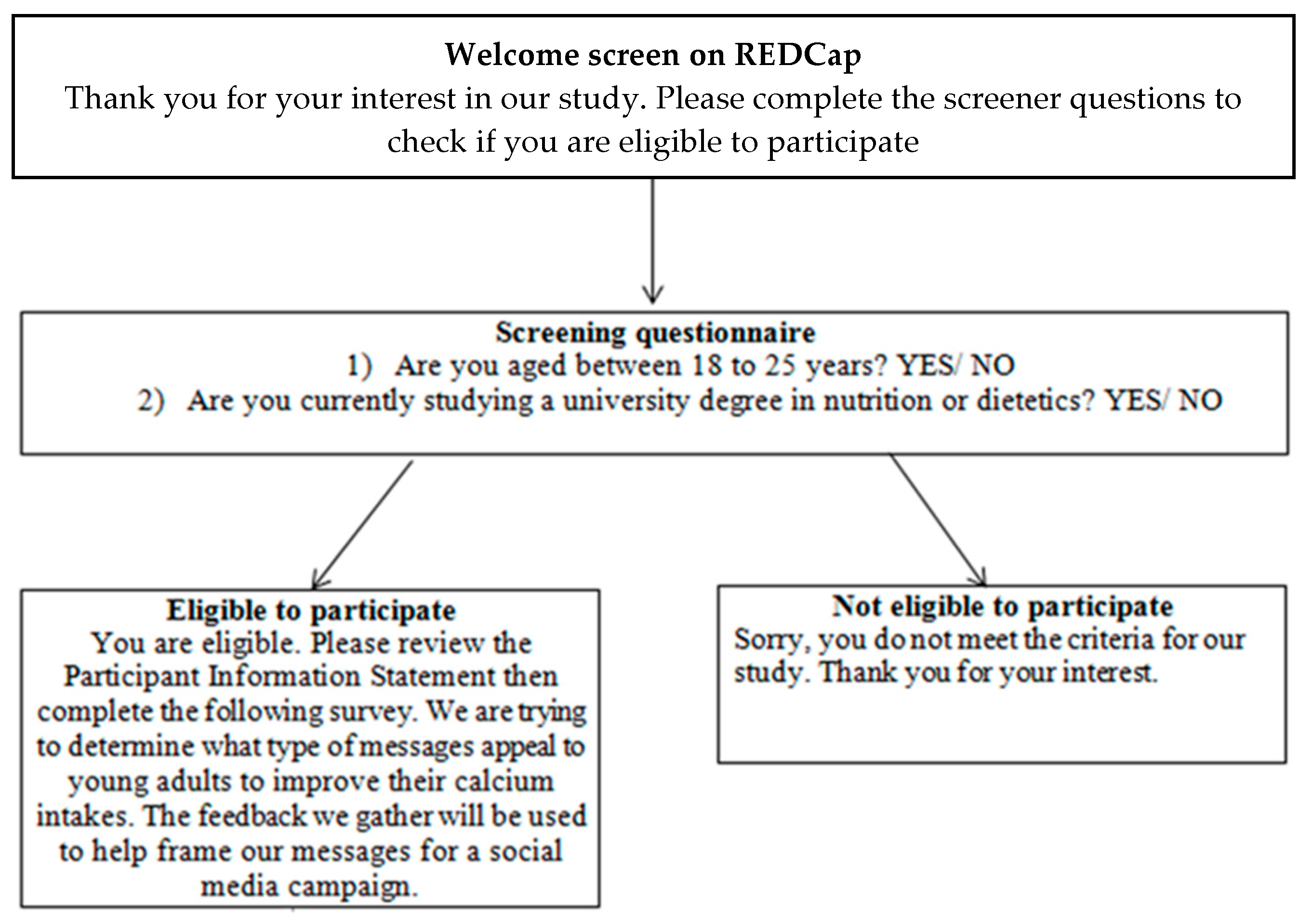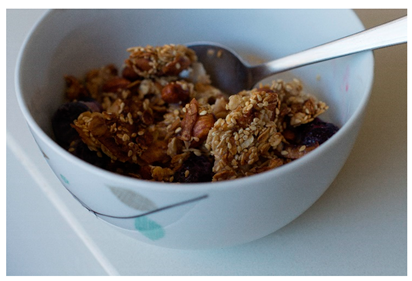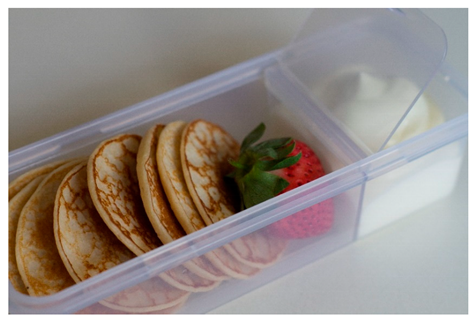Messaging for Interventions Aiming to Improve Calcium Intake in Young Adults—A Mixed Methods Study
Abstract
1. Introduction
2. Materials and Methods
2.1. Study Design
2.2. Survey Development
2.3. Recruitment
2.4. Data Analyses.
3. Results
3.1. Sample Characteristics
3.2. Quantitative Analyses
3.3. Personal Relevance
3.4. Thematic Analysis of Open Comments
3.4.1. Tone and Text
3.4.2. Personal Relevance
3.4.3. Motivators
4. Discussion
5. Study Limitations and Future Implications
6. Conclusions
Author Contributions
Funding
Conflicts of Interest
References
- Jackson, H.; Shiell, A. Preventive Health: How Much Does Australia Spend and Is It Enough? Foundation for Alcohol Research and Education: Canberra, Australia, 2017. [Google Scholar]
- Australian National Preventive Health Agency (ANPHA). State of Preventive Health 2013. Report to the Australian Government Minister for Health; ANHPA: Canberra, Australia, 2013. [Google Scholar]
- Weaver, C.M.; Gordon, C.M.; Janz, K.F.; Kalkwarf, H.J.; Lappe, J.M.; Lewis, R.; O’Karma, M.; Wallace, T.C. The National Osteoporosis Foundation’s position statement on peak bone mass development and lifestyle factors: A systematic review and implementation recommendations. Osteoporos. Int. 2016, 27, 1281–1386. [Google Scholar] [CrossRef] [PubMed]
- Prentice, A. Diet, nutrition and the prevention of osteoporosis. Public Health Nutr. 2004, 7, 227–243. [Google Scholar] [CrossRef] [PubMed]
- Rouf, A.S.; Zhixian, S.; Rangan, A.; Grech, A.; Allman-Farinelli, M. Low calcium intakes among Australian adolescents and young adults are associated with higher consumption of discretionary foods and beverages. Nutrition 2018, 55–56, 146–153. [Google Scholar] [CrossRef] [PubMed]
- Mulye, T.P.; Park, M.J.; Nelson, C.D.; Adams, S.H.; Irwin, C.E., Jr.; Brindis, C.D. Trends in adolescent and young adult health in the United States. J. Adolesc. Health 2009, 45, 8–24. [Google Scholar] [CrossRef] [PubMed]
- Pew Research Center. Social Media Use in 2018; Pew Research Center: Washington, DC, USA, 2018; pp. 1–17. [Google Scholar]
- Jacobs, W.; Amuta, A.O.; Jeon, K.C. Health information seeking in the digital age: An analysis of health information seeking behavior among US adults. Cogent Soc. Sci. 2017, 3. [Google Scholar] [CrossRef]
- Fox, S. Health Topics. 2011. Pew Research Center, Internet and Technology. Available online: http://www.pewinternet.org/2011/02/01/health-topics-2/ (accessed on 3 November 2018).
- Metzger, M.J.; Flanagin, A.J. Credibility and trust of information in online environments: The use of cognitive heuristics. J. Pragmat. 2013, 59, 210–220. [Google Scholar] [CrossRef]
- Flanagin, A.; Metzger, M. Digital Media and Youth: Unparalleled Opportunity and Unprecedented Responsibility; Series on Digital Media and Learning; The MIT Press: Cambridge, MA, USA, 2008. [Google Scholar]
- Strong, K.A.; Parks, S.L.; Anderson, E.; Winett, R.; Davy, B.M. Weight Gain Prevention: Identifying Theory-Based Targets for Health Behavior Change in Young Adults. J. Am. Diet. Assoc. 2008, 108, 1708–1715. [Google Scholar] [CrossRef] [PubMed]
- Updegraff, J.A.; Brick, C.; Emanuel, A.S.; Mintzer, R.E.; Sherman, D.K. Message Framing for Health: Moderation by Perceived Susceptibility and Motivational Orientation in a Diverse Sample of Americans. Health Psychol. 2015, 34, 20–29. [Google Scholar] [CrossRef] [PubMed]
- Shamaskin, A.M.; Mikels, J.A.; Reed, A.E. Getting the message across: Age differences in the positive and negative framing of health care messages. Psychol. Aging 2010, 25, 746–751. [Google Scholar] [CrossRef] [PubMed]
- Mikels, J.A.; Shuster, M.M.; Thai, S.T.; Smith-Ray, R.; Waugh, C.E.; Roth, K.; Keilly, A.; Stine-Morrow, E.A. Messages that Matter: Age Differences in Affective Responses to Framed Health Messages. Psychol. Aging 2016, 31, 409–414. [Google Scholar] [CrossRef] [PubMed]
- Kessels, L.T.; Ruiter, R.A.; Brug, J.; Jansma, B.M. The effects of tailored and threatening nutrition information on message attention. Evidence from an event-related potential study. Appetite 2011, 56, 32–38. [Google Scholar] [CrossRef] [PubMed]
- Petty, R.E.; Barden, J.; Wheeler, S. The Elaboration Likelihood Model of Persuasion: Developing Health Promotions for Sustained Behavioral Change. In Emerging Theories in Health Promotion Practice and Research; DiClemente, R.J., Crosby, R.A., Kegler, M., Eds.; Jossey-Bass: San Francisco, CA, USA, 2009; pp. 185–214. [Google Scholar]
- Dijkstra, A.; Ballast, K. Personalization and perceived personal relevance in computer-tailored persuasion in smoking cessation. Br. J. Health Psychol. 2012, 17, 60–73. [Google Scholar] [CrossRef] [PubMed]
- Hales, S.B.; Davidson, C.; Turner-McGrievy, G.M. Varying Social Media Post Types Differentially Impacts Engagement in a Behavioral Weight Loss Intervention. Transl. Behav. Med. 2014, 4, 355–362. [Google Scholar] [CrossRef] [PubMed]
- Siopis, G.; Chey, T.; Allman-Farinelli, M. A systematic review and meta-analysis of interventions for weight management using text messaging. J. Hum. Nutr. Diet. 2015, 28, 1–15. [Google Scholar] [CrossRef] [PubMed]
- Pollard, C.M.; Howat, P.A.; Pratt, I.S.; Boushey, C.J.; Delp, E.J.; Kerr, D.A. Preferred Tone of Nutrition Text Messages for Young Adults: Focus Group Testing. JMIR mHealth uHealth 2016, 4, e1. [Google Scholar] [CrossRef] [PubMed]
- Peters, B.S.E.; Verly, E., Jr.; Marchioni, D.M.L.; Fisberg, M.; Martini, L.A. The influence of breakfast and dairy products on dietary calcium and vitamin D intake in postpubertal adolescents and young adults. J. Hum. Nutr. Diet. 2012, 25, 69–74. [Google Scholar] [CrossRef] [PubMed]
- Vanderbilt University. Project REDCap. 2018. Available online: https://projectredcap.org/ (accessed on 8 February 2018).
- Braun, V.; Clarke, V. Using thematic analysis in psychology. Qual. Res. Psychol. 2006, 3, 77–101. [Google Scholar] [CrossRef]
- Anderson, C. Presenting and Evaluating Qualitative Research. Am. J. Pharm. Educ. 2010, 74, 141. [Google Scholar] [CrossRef] [PubMed]
- Strekalova, Y.A.; Krieger, J.L. A Picture Really is Worth a Thousand Words: Public Engagement with the National Cancer Institute on Social Media. J. Cancer Educ. 2017, 32, 155–157. [Google Scholar] [CrossRef] [PubMed]
- Pollard, C. Why Visual Content Is a Social Media Secret Weapon. 2017. Available online: https://www.huffingtonpost.com/catriona-pollard/why-visual-content-is-a-s_b_7261876.html (accessed on 19 July 2018).
- HubSpot. Photos on Facebook Generate 53% More Likes Than the Average Post [NEW DATA]. 2017. Available online: https://blog.hubspot.com/blog/tabid/6307/bid/33800/photos-on-facebook-generate-53-more-likes-than-the-average-post-new-data.aspx (accessed on 20 July 2018).
- eMarketer. Important Factors That Make Visual Content Successful According to Marketing Decision-Makers Worldwide, March 2016 (% of Respondents). 2016. Available online: https://www.emarketer.com/Chart/Important-Factors-that-Make-Visual-Content-Successful-According-Marketing-Decision-Makers-Worldwide-March-2016-of-respondents/192604 (accessed on 20 July 2018).
- Mayer, R.E. Multimedia Learning, 2nd ed.; Cambridge University Press: Cambridge, UK, 2009. [Google Scholar]
- Surgenor, D.; Hollywood, L.; Furey, S.; Lavelle, F.; McGowan, L.; Spence, M.; Raats, M.; McCloat, A.; Mooney, E.; Caraher, M.; et al. The impact of video technology on learning: A cooking skills experiment. Appetite 2017, 114 (Suppl. C), 306–312. [Google Scholar] [CrossRef] [PubMed]
- Nour, M.M.; Rouf, A.S.; Allman-Farinelli, M. Exploring young adult perspectives on the use of gamification and social media in a smartphone platform for improving vegetable intake. Appetite 2018, 120 (Suppl. C), 547–556. [Google Scholar] [CrossRef] [PubMed]
- Pelletier, J.E.; Laska, M.N. Balancing healthy meals and busy lives: Associations between work, school and family responsibilities and perceived time constraints among young adults. J. Nutr. Educ. Behav. 2012, 44, 481–489. [Google Scholar] [CrossRef] [PubMed]
- McCracken, M.; Jiles, R.; Blanck, H.M. Health Behaviors of the Young Adult, U.S. Population: Behavioral Risk Factor Surveillance System, 2003. Prev. Chronic Dis. 2007, 4, A25. [Google Scholar] [PubMed]
- Hattersley, L.; Irwin, M.; King, L.; Allman-Farinelli, M. Determinants and patterns of soft drink consumption in young adults: A qualitative analysis. Public Health Nutr. 2009, 12, 1816–1822. [Google Scholar] [CrossRef] [PubMed]
- Hebden, L.; Balestracci, K.; McGeechan, K.; Denney-Wilson, E.; Harris, M.; Bauman, A.; Allman-Farinelli, M. ‘TXT2BFiT’ a mobile phone-based healthy lifestyle program for preventing unhealthy weight gain in young adults: Study protocol for a randomized controlled trial. Trials 2013, 14, 75. [Google Scholar] [CrossRef] [PubMed]
- Ashton, L.M.; Hutchesson, M.J.; Rollo, M.E.; Morgan, P.J.; Thompson, D.I.; Collins, C.E. Young adult males’ motivators and perceived barriers towards eating healthily and being active: A qualitative study. Int. J. Behav. Nutr. Phys. Act. 2015, 12, 93. [Google Scholar] [CrossRef] [PubMed]
- Walsh, J.R.; White, A.A.; Greaney, M.L. Using focus groups to identify factors affecting healthy weight maintenance in college men. Nutr. Res. 2009, 29, 371–378. [Google Scholar] [CrossRef] [PubMed]
- Hutchesson, M.J.; Morgan, P.J.; Callister, R.; Pranata, I.; Skinner, G.; Collins, C.E. Be Positive Be Healthe: Development and Implementation of a Targeted e-Health Weight Loss Program for Young Women. Telemed. e-Health 2016, 22, 519–528. [Google Scholar] [CrossRef] [PubMed]
- Holley, T.J.; Collins, C.E.; Morgan, P.J.; Callister, R.; Hutchesson, M.J. Weight expectations, motivations for weight change and perceived factors influencing weight management in young Australian women: A cross-sectional study. Public Health Nutr. 2015, 19, 275–286. [Google Scholar] [CrossRef] [PubMed]
- Centre for Disease Control and Prevention. CDC’s Guide to Writing for Social Media; Centre for Disease Control and Prevention: Atlanta, GA, USA, 2012. [Google Scholar]
- Kourouniotis, S.; Keast, R.S.J.; Riddell, L.J.; Lacy, K.; Thorpe, M.G.; Cicerale, S. The importance of taste on dietary choice, behaviour and intake in a group of young adults. Appetite 2016, 103 (Suppl. C), 1–7. [Google Scholar] [CrossRef] [PubMed]
- Poobalan, A.S.; Aucott, L.S.; Clarke, A.; Smith, W.C.S. Diet behaviour among young people in transition to adulthood (18–25 year olds): A mixed method study. Health Psychol. Behav. Med. 2014, 2, 909–928. [Google Scholar] [CrossRef] [PubMed]
- Tyrrell, R.L.; Townshend, T.G.; Adamson, A.J.; Lake, A.A. ‘I’m not trusted in the kitchen’: Food environments and food behaviours of young people attending school and college. J. Public Health 2016, 38, 289–299. [Google Scholar] [CrossRef] [PubMed]
- Tyrrell, R.L.; Greenhalgh, F.; Hodgson, S.; Wills, W.J.; Mathers, J.C.; Adamson, A.J.; Lake, A.A. Food environments of young people: Linking individual behaviour to environmental context. J. Public Health 2017, 39, 95–104. [Google Scholar] [CrossRef] [PubMed]
- Marcinow, M.L.; Randall Simpson, J.A.; Whiting, S.J.; Jung, M.E.; Buchholz, A.C. Young Adults’ Perceptions of Calcium Intake and Health: A. Qualitative Study. Health Educ. Behav. 2017, 44, 898–906. [Google Scholar] [CrossRef] [PubMed]
- Fergie, G.; Hunt, K.; Hilton, S. Social media as a space for support: Young adults’ perspectives on producing and consuming user-generated content about diabetes and mental health. Soc. Sci. Med. (1982) 2016, 170, 46–54. [Google Scholar] [CrossRef] [PubMed]
- Boyd, D. Why Youth (Heart) Social Network Sites: The Role of Networked Publics in Teenage Social Life; MIT Press: Cambridge, MA, USA, 2007; pp. 119–142. [Google Scholar]
- Ellison, N.; Heino, R.; Gibbs, J. Self-presentation processes in the online dating environment. J. Comput. Mediat. Commun. 2006, 11, 415–441. [Google Scholar] [CrossRef]
- Zhang, S.; Jiang, H.; Carroll, J. Social Identity in Facebook Community Life. Int. J. Virtual Communities Soc. Netw. 2010, 2, 64–76. [Google Scholar] [CrossRef]
- Gündüz, U. The Effect of Social Media on Identity Construction. Mediterr. J. Soc. Sci. 2017, 8, 85–92. [Google Scholar] [CrossRef]
- Goffman, E. The Presentation of Self in Everyday Life; Anchor Books: New York, NY, USA, 1959. [Google Scholar]
- Kerr, D.A.; Harray, A.J.; Pollard, C.M.; Dhaliwal, S.S.; Delp, E.J.; Howat, P.A.; Pickering, M.R.; Ahmad, Z.; Meng, X.; Pratt, I.S.; et al. The connecting health and technology study: A 6-month randomized controlled trial to improve nutrition behaviours using a mobile food record and text messaging support in young adults. Int. J. Behav. Nutr. Phys. Act. 2016, 13, 52. [Google Scholar] [CrossRef] [PubMed]

| Characteristics | n |
|---|---|
| Males | 17 |
| Age, years | |
| 18–20 | 21 |
| 21–25 | 60 |
| Occupation | |
| Full-time student | 57 |
| Part-time student | 4 |
| Working full-time | 16 |
| Other | 4 |
| Message | Tone of Voice | Mean Score |
|---|---|---|
| It is important to get your calcium every day as it can lower your risk of chronic diseases. If you are not meeting your recommendations, it is time to make to a change and start being a healthier you at breakfast! | Authoritative | 3.3 |
| We understand that it is hard for you to eat healthy when you have a very busy life, but planning your meals early will make it easier. You could start with planning your breakfast the night before with something as simple as yoghurt and muesli? | Empathetic | 3.1 |
| Plan your brekkie the night before and step up your brekkie game! Add some milk or yoghurt and you’re good to go #brekkielikeaboss | Generation Y | 2.8 |
| Did you know that breakfast is an easy way to boost your calcium intake? Start your day by pouring some milk on your cereal or top some yoghurt on your muesli. | Solution-based | 2.7 |
| Being in a rush in the morning can often mean grabbing breakfast from outside. Why not start planning your breakfast the night before to save yourself from making unplanned purchases in the morning? | Substitution-based | 3.0 |
| Mock Post Example | Mean Score |
|---|---|
Research has shown that consuming breakfast is associated with positive health outcomes including improved cognitive function and memory. If you are not a breakfast eater, it is time to make a change and look after yourself! Why don’t you start with this overnight chia pudding? Like this post if you want us to share the recipe.  | 3.1 |
We know that it is difficult to wake up early for breakfast because sleep is so precious! And this is why we have created easy granola recipes like these so you can get the best of both worlds. Like this post if you want us to share the recipe. | 3.2 |
Need a sweet fix? We’ve got you covered with this delicious chocolate mousse. We have used ricotta and almonds here to bump up the calcium content. Like this post if you want us to share the recipe. | 2.6 |
Craving a sweet dessert? Satisfy your craving with these cute pikelets that are calcium-rich and delicious. Like this post if you want us to share the recipe.  | 3.1 |
Instead of purchasing pancakes from outside, why don’t you make some on your own? These calcium-rich ricotta pancakes will curb your sweet craving and keep you feeling satisfied! Like this post if you want us to share the recipe.  | 3.0 |
© 2018 by the authors. Licensee MDPI, Basel, Switzerland. This article is an open access article distributed under the terms and conditions of the Creative Commons Attribution (CC BY) license (http://creativecommons.org/licenses/by/4.0/).
Share and Cite
Rouf, A.; Allman-Farinelli, M. Messaging for Interventions Aiming to Improve Calcium Intake in Young Adults—A Mixed Methods Study. Nutrients 2018, 10, 1673. https://doi.org/10.3390/nu10111673
Rouf A, Allman-Farinelli M. Messaging for Interventions Aiming to Improve Calcium Intake in Young Adults—A Mixed Methods Study. Nutrients. 2018; 10(11):1673. https://doi.org/10.3390/nu10111673
Chicago/Turabian StyleRouf, Anika, and Margaret Allman-Farinelli. 2018. "Messaging for Interventions Aiming to Improve Calcium Intake in Young Adults—A Mixed Methods Study" Nutrients 10, no. 11: 1673. https://doi.org/10.3390/nu10111673
APA StyleRouf, A., & Allman-Farinelli, M. (2018). Messaging for Interventions Aiming to Improve Calcium Intake in Young Adults—A Mixed Methods Study. Nutrients, 10(11), 1673. https://doi.org/10.3390/nu10111673






